Brewer’s Blackbird – November 13
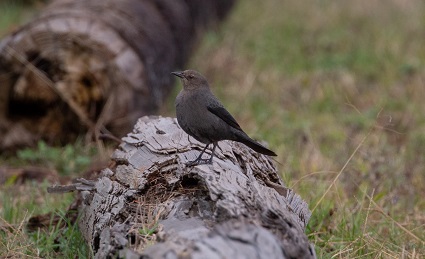
It’s always a good idea to take a close look at birds because you never know when something odd will appear. From afar, this bird appears to be one of our more common blackbird species, but upon closer inspection its two-toned wing and straight bill shape were noticed. This lone blackbird turned out to be the third recording of a Brewers Blackbird in Monmouth County and stayed for just one day. Who knows, it might visit one of your local parks with open habitat!
Bonaparte’s Gull – November 21
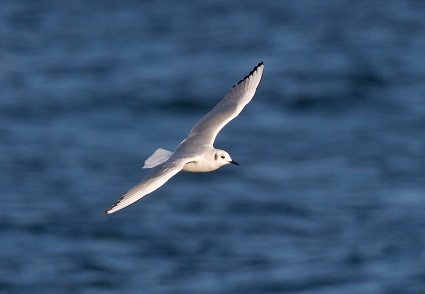
When people think of gulls, they often think of a typical summer beach scene with gulls hovering over an unsuspecting child eating french fries in the hopes of catching a stray fry. However, gulls are an awesome family of birds that’s much richer than that image.
Of the expected gulls to see in our area, the Bonaparte’s gull is not the most common, but it does appear seasonally. During winter, they can be spotted just off the coast, flying low over the water with tern-like agility.
These small, elegant gulls breed in northern boreal forests and head south in the winter. Adults have flashy white primaries that form a distinctive outer white wedge along their wings. They have been spotted at
Seven Presidents Ocean Front Park,
Bayshore Waterfront Park, and
Fisherman’s Cove Conservation Area.
Brant
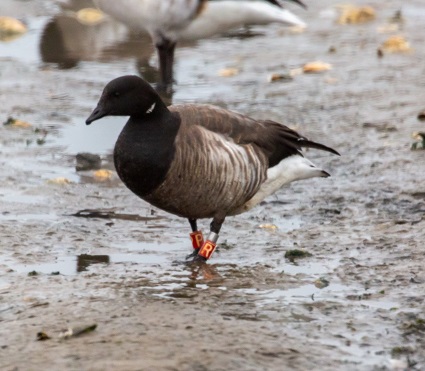
A locally banded Brant
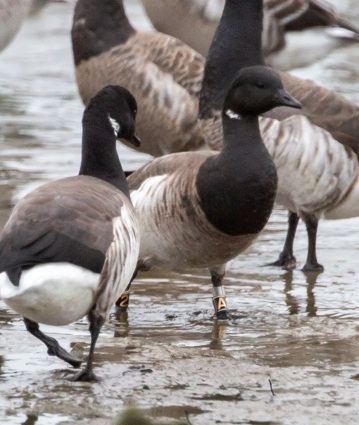
A Brant banded in Winnipeg, Canada
What really stood out were the bands around their legs. These small bands help scientists to track migrating birds. Federal bands are silver with a series of letters and numbers inscribed to identify each individual bird. They can be quite difficult to read in the field and recapture is usually required to read it.
Sometimes certain species, such as these Brants, are given more colorful, easy-to-read bands known as auxiliary markers for easier identification. These band codes can be submitted to the United States Geological Survey as part of citizen science so researchers can track where banded birds are seen. Submitters are given a certificate of appreciation with additional information on that individual bird, including where it was originally banded. Sometimes they are very locally or recently banded birds, and sometimes they are foreign or older banded birds. So keep your eyes and cameras ready to get involved with this cool aspect of citizen science and help further our knowledge about birds. (posted 12/20/2022)
Winter Garden
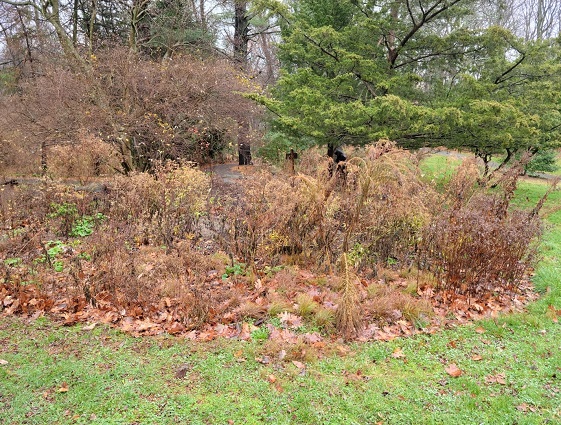
I know what you’re thinking, this garden looks abandoned, unkempt, and in need of some TLC. But the surprising truth is that this messy garden is the perfect habitat for our overwintering wildlife!
Let’s take it from the top. All of those dried seed heads provide ample nutrition for our overwintering songbirds. They require all of those calories in order to keep warm until spring.
As we move down the plants themselves, many native perennials contain hollow stems. These narrow spaces provide wintering sites for native bees. Some bee species even create a series of chambers within the stem, each containing an egg and a small supply of nectar and pollen for the larva to sustain themselves on.
Upon looking at the ground, many people will notice the layer of leaves strewn about. Most people might even feel compelled to bag the leaves up and discard them. Fortunately, nature has it all figured out! Leaf litter, also called duff, insulates the soil from harsh temperatures, protecting plant roots in the process. Often overlooked, many species of moths overwinter in the duff as cocoons, using camouflage to look like dried leaves.
I’ll leave you with this mental exercise. The next time you look at a winter garden bed that appears to be messy, use your imagination and think about all of the small creatures that are relying on these plants, lying dormant until the springtime. (posted12/8/2022)
Why Leaves Change Color
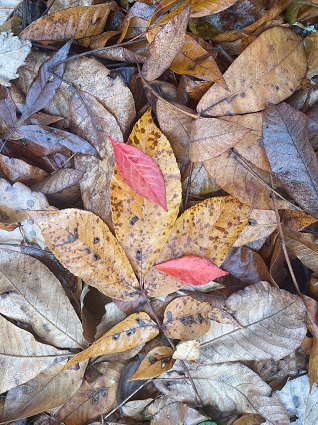
Have you ever wondered why leaves change color? For most of the year leaves are green because of the chlorophyll they use to absorb energy from the sun. Leaves convert that energy into sugars to feed the tree.
During the fall season the days get shorter, the temperature starts to drop, and there is less sunlight. Without enough sunlight, the chlorophyll in the leaves starts to break down and reveals the hidden pigments underneath. That’s when we start to see those beautiful warm yellows, oranges and even reds. The darker red colors that you see come from a pigment called anthocyanin, which isn’t always present and happens when sugars are trapped in the leaves.
Though there are some trees that produce this pigment in abundance like red maples, oaks, and sumacs. These species often put on a display of beautiful reds that really stand out against the landscape in the fall, just like these pictured burning bush leaves. (posted 12/8/2022)
Lichen
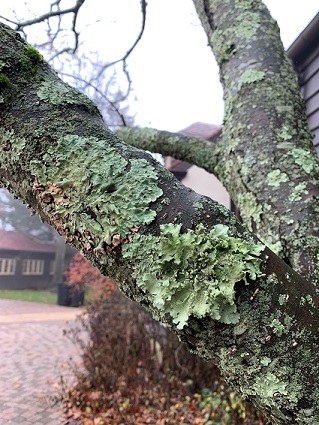
Have you ever been on a walk through the forest and wondered what the green material attached to the bark of a tree was? This is something called lichen! Lichen is a complex organism that develops from a partnership between two different organisms, a fungus and an algae. The partnership between the fungus and algae is known as a symbiotic relationship or symbiosis. A symbiotic relationship is a long-term interaction between two different species where each species benefits from one another. In this case, the algae provides energy to the fungus by performing photosynthesis and the fungus provides nutrients and a home for the algae as the algae’s cells reside inside the fungus. This photo was taken outside the Huber Woods Environmental Center, Middletown, and wow, this fungus and algae sure took a lichen to one another! (posted 12/7/2022)
Northern Bobwhite
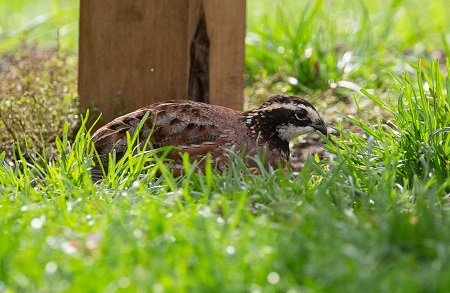
It is usually easier to hear than see a Northern Bobwhite when its loud whistled “bob-white” call is coming from a grassy field. It is a small, very secretive, well camouflaged bird in the quail family. The males, such as the one recently seen feeding at the Huber Woods Environmental Center, have a strong black and white striped face with a white throat and brown cap. Populations in New Jersey have experienced steep declines due to habitat loss. Most Northern Bobwhites found today are suspected to not be truly wild as most have been extirpated. (posted 11/9/2022)
Possible Hammonds Flycatcher
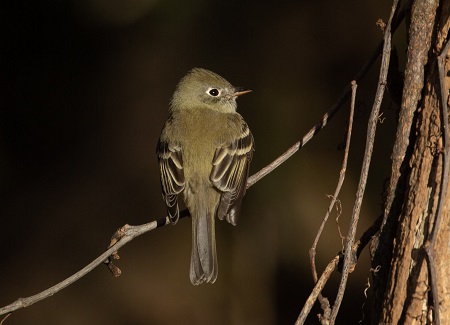
Sometimes knowing when a bird looks different is just as important as knowing exactly what species it is. One of our Park System Naturalists and four other local birders recently had such an experience at Sandy Hook when they found a flycatcher that didn’t quite check off the field marks for any local ones. In a family of birds that is notoriously hard to identify, it was a mystery.
Sometimes it takes phoning a friend who has more expertise to make an identification, so our Park System Naturalist called on a few experts and sent them photos. The images of the bird show a slight crest, a small bill, a steep forehead angle, and a bold but messy eye ring that is wider at the back. They also show that its gray head has a contrasting greenish back and there is low contrast gray on the bird’s throat and vest. It has a yellowish belly and a long primary projection that makes its slightly forked tail appear short when coupled with a large primary gap and a medium wing panel bar contrast.
Using these details, our Park System Naturalist and the birding experts he consulted are leaning toward identifying this bird as a Hammonds Flycatcher. If so, it will be the first documented one in New Jersey. Time will tell if it is accepted by the New Jersey Bird Records Committee as the state’s first recorded Hammonds Flycatcher. (posted 11/1/2022)
Rainbow
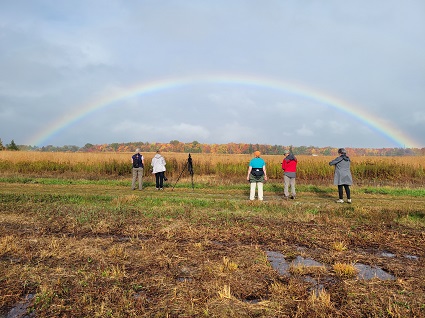
After a brief rain shower during a recent Park System Autumn Birding Expedition trip to the Pole Farm section of Mercer Meadows, participants were looking at a Northern Harrier perched on a box at the edge of a field when this exceptionally beautiful rainbow appeared. (posted 10/27/2022)
Barred Owl
Owls are often elusive nighttime predators; however, they can occasionally be spotted during the day. During a recent Park System birding trip to the Great Swamp National Wildlife Refuge, our group was lucky enough to have just such an encounter. This beautiful Barred Owl was being harassed by Blue Jays when our Park System Naturalist saw it fly and land on a nearby branch. Everyone in the group was able to see the bird through binoculars and use a spotting scope for an even closer look. It’s a memory none will forget. (posted 10/19/2022)
Black Tern

After a recent storm, one of our Park System Naturalists took a walk along the newly formed beach (appearing during dry summer months) near the Manasquan Reservoir Environmental Center, Howell. To his surprise, he noticed an interesting bird flying close to shore, flapping with a tern-like flight. Its darker overall appearance eliminated it as being one of the terns that regularly visit the site. It was soon identified as a Black Tern. This sighting was the first record of a Black Tern at the Manasquan Reservoir. Once word got out in the birding community, people came out to see it. Remarkably, at least four of these birds were spotted together. The spectacle of multiple Black Terns only lasted that afternoon. By the next day, there was only one left that stuck around for a few days before flying off. (posted 9/30/2022)
Halloween Pennant
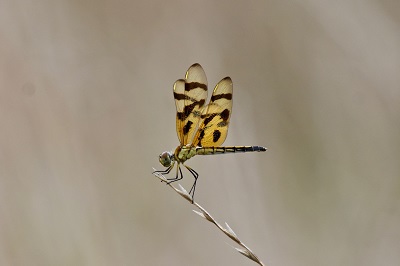
The Halloween pennant dragonflies are aptly named for their orange color and black-banded wings. They can be found waving in the breeze on the tips of tall reeds and grasses along marshes, ponds and lakes. The open fields along Marlu Lake and Swimming River Reservoir in Thompson Park create an ideal habitat for these beneficial insects. (posted 9/12/2022)
Black and Yellow Garden Spider
These large, orb-weaving arachnids spin intricate webs on plants in sunny areas to capture their prey. This particular female caught herself a yellowjacket along a woodland edge at
Hartshorne Woods Park. (posted 9/12/2022)
Golden Alexander
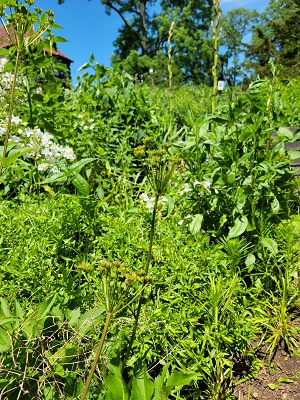
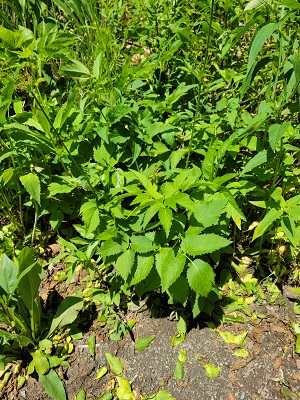
Behold, the mighty Golden Alexander! While this plant is not very well known in the gardening world, it certainly has its fans. Pictured on the right towards the top of the flower stalk is a tiny Black Swallowtail caterpillar. This larval form will feed on the nutritious foliage until it is ready to metamorphosize into a butterfly.
Gardeners have more than likely spotted these caterpillars on their dill, parsley, or fennel leaves. Golden Alexander is their native North American cousin, the natural host plant for the Black Swallowtail. Remarkably, Golden Alexander can grow in a range of conditions, tolerating full sun to full shade. During the spring, it sends up vertical stalks with yellow flower umbels to admire. Consider growing this lovely plant in your garden! (posted 6/23/2022)
Spring Birding
Spring is prime time to get out and see nature! This is especially true for bird enthusiasts thanks to the diversity of bird species found in our parks. April and May are peak season for warblers - those small, mostly yellow, confusing, and similar looking family of birds.
Palm Warbler
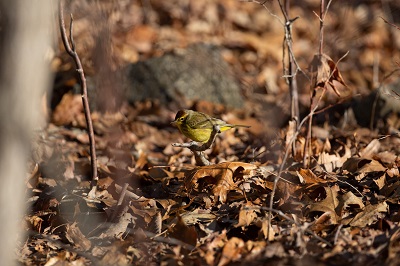
Early visitors include the Palm Warbler. This mostly yellow warbler has a rusty streak on its breast and a rusty red cap. They are plump birds that tend to stay low to the ground and continuously pump their tails.
Pine Warbler
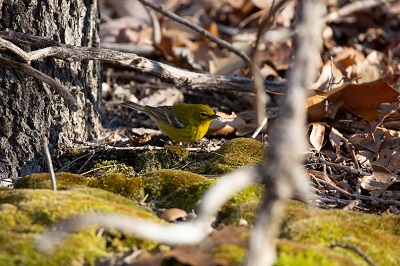
Another early migrant is the Pine Warbler. True to its name, it likes pine forests. A yellowish warbler with a yellow throat and broken yellow eye ring, it has greyish black wings with white wing bars. You can usually find them by their musical trill-like song.
Yellow Warbler
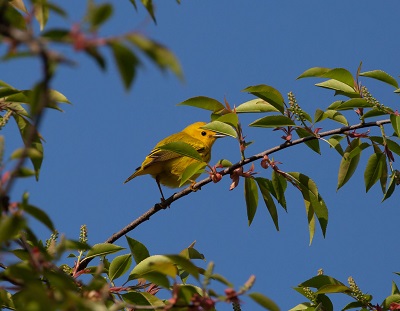
One of the most strikingly, brilliantly colored warblers is the Yellow Warbler. Bright yellow overall, the males have chestnut streaking on their chest, dark beady black eyes, and a thick black bill. They can be easily found by their sweet-whistled tune with a neat mnemonic of “sweet, sweet, sweet, I’m so sweet.”
Chestnut-sided Warbler
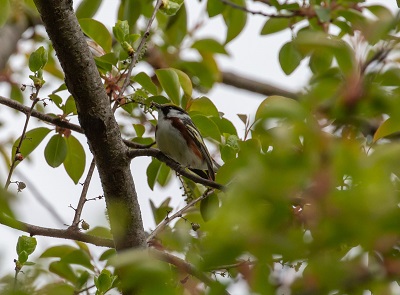
Some warblers have more than just yellow coloration. This warbler is aptly named for the chestnut coloration on the sides of the male. They have a bright yellow cap and a yellowish color on their wings. They tend to forage in the trees, feeding on insects on the underside of leaves. Patience is key to spotting these birds as they bounce from leaf to leaf.
Not all warblers are yellow; some are more brownish in color. These are usually the ones that are feeding and spending more time on the ground.
Ovenbird
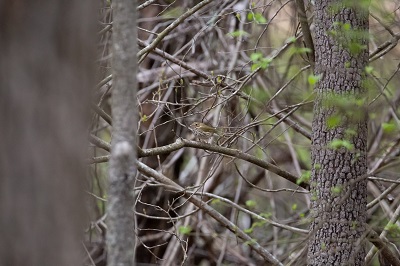
A common, but often overlooked, brownish warbler is the Ovenbird. Its olive brown back helps it blend in with the leaflitter as it walks on the forest floor. If you catch a glimpse of one, you’ll notice its beautiful spotted chest, white eye ring, and black and orange crown stripes. It is often heard singing a very loud, repetitive song, with the mnemonic “teacher, teacher, teacher, teacher, teacher.”
Worm-eating Warbler
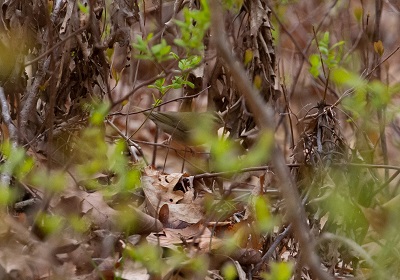
A not-so-common warbler that can be found in Monmouth County is the beautiful Worm-eating Warbler. Overall, it is olive color with a buff face and black stripes on its head. It prefers to hunt the understory and can usually be found hunting for insects and spiders in clusters of dead hanging leaves.
Warblers are not the only exciting migrants to be visiting in the spring. Other highlights include:
Blue-headed Vireo
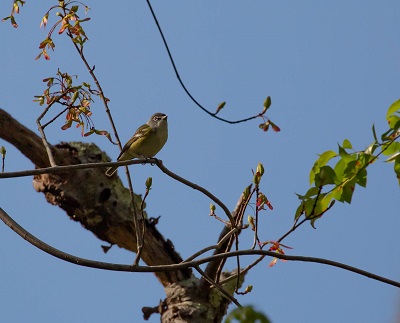
The Blue-headed Vireo is one of the earliest vireos to pass through our area each spring. They have a beautiful blue head, a bold white “spectacle” eye ring, and a white loral spot just above their bill. Much like warblers, they forage in trees picking insects but at a slightly slower pace.
Great Crested Flycatcher
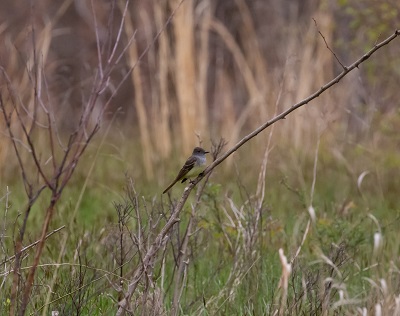
The Great Crested Flycatcher is a large flycatcher that is easily found by its loud, high-pitched “whee-eep” whistle. It has a brilliant yellow belly, grey throat, brown wings, brownish cap, and a tail that is reddish on the underside. These birds usually hunt high in the canopy and can be seen swooping between branches where they will perch.
Ruby-throated Hummingbirds
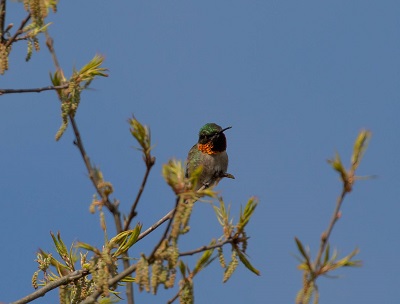
Ruby-throated Hummingbirds are a highlight for all when they return in the spring with their vibrant flashes of green and red. Tiny and energetic, they can be seen visiting our homes and forests in a continuous effort to find sweet food sources. They especially love the nectar of certain flower species. Flower gardens and feeders are a great way to attract these little gems to your homes.
Mourning Cloak Butterflies
Mourning Cloak Butterflies are also a spring treat that can be found within the forests of our local county parks. A large butterfly with an overall dark brown coloration, they have yellow and blue dots and yellow edges along the dorsal sides of their wings. The ventral (or underside) of the wings has grey striations that help it camouflage on the bark of trees when it lands. They are one of the first butterflies to emerge in the spring, and a happy sight for those ready for the end of winter. (posted 5/11/2022)
A group of American Avocets were recently spotted feeding in the mud flats in the Hillside Road area of Shark River Park. These stunning birds really stand out in a flock. Their bodies are white with black and white wings, and, when in breeding plumage, a pinkish head. They wade in shallow waters on their long legs, swishing their slender upturned bills from side to side, to feed on aquatic invertebrates. These birds are uncommon in our area and were a real treat to see feeding and swimming. (posed 4/7/2022)
Red Fox at Thompson Park
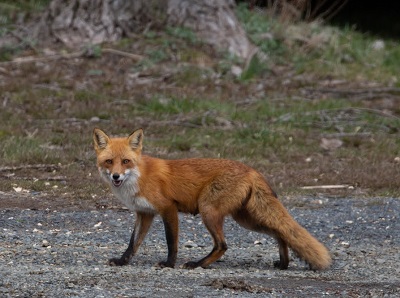
Red foxes are a beautiful sight when you catch a glimpse of them in our parks. This fox was spotted visiting Marlu Lake in Thompson Park, Lincroft. They are usually solitary animals except when breeding and raising pups. They have adapted well to human changes in the environment and can be found in a wide variety of habitats. They typically have a range of 2-8 square miles and will have multiple dens that get used throughout the seasons. Although they are cute, it is important to remember they are wild animals and you should never try to feed or leave food out for them. (posted 4/1/2022)
Finches
For beginning birders, a tough identification to make is the Purple Finch versus the House Finch. In Monmouth County, the House Finch is the more common species to see. However, we do get visited by Purple Finches. During a recent trip to Holmdel Park, a visit to its Arboretum yielded sightings of both the male and female Purple Finch. They are small finches with thick conical bills. The male has raspberry red coloration overall and the female is coarsely streaked with brown on its chest and belly. Both have strong facial markings that include an “eyebrow” appearance. These Purple Finches were observed feeding on the soft buds of trees that are just starting to appear for spring.
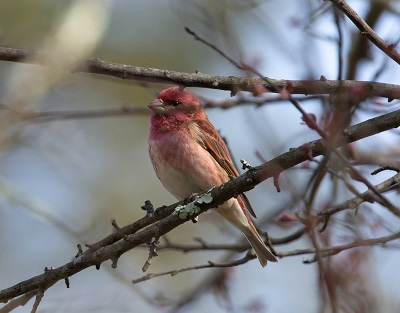
Male Purple Finch at Holmdel Park Arboretum. Note the raspberry red color that continues down the belly and flanks.
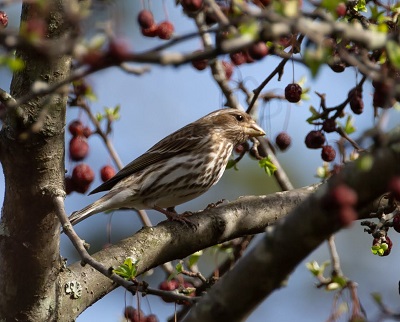
Female Purple Finch at Holmdel Park Arboretum. Note the thick coarse brown streaks and the appearance of white “eyebrow” on the face of the bird.
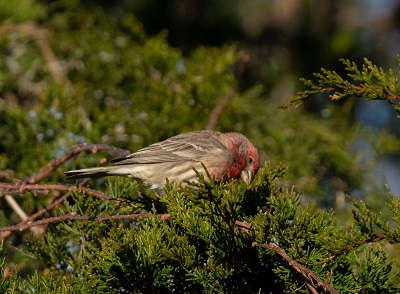
Male House Finch at Barnegat Light State Park. Note the red color that is mainly on the face of the bird and not down into the belly and flanks of the bird. (posted 3/28/2022)
Eurasian Green-winged Teal
Recently an “odd bird” was spotted by Rob Fanning while birding around Thompson Park. At first glimpse it appeared to be a Green-winged Teal, but upon closer inspection with a spotting scope, something interesting was noticed. The white stripe on the bird was horizontal instead of vertical. This very fine detail revealed that the bird was a Eurasian Green-winged Teal, also known as a Common Teal or Eurasian Teal, and not our normal Green-winged Teal. Although they are still considered one species by many authorities, they are distinct enough to differentiate between in the field.
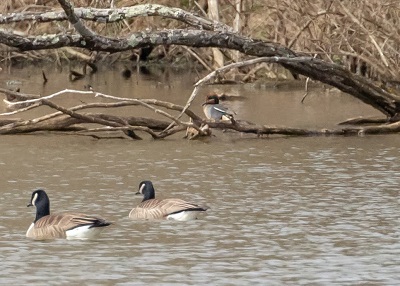
Eurasian Green-winged Teal (Common Teal) at Thompson Park showing horizontal white stripe.
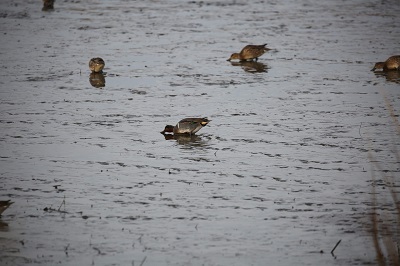
Green-winged Teal at Forsythe Wildlife Drive showing horizontal white stripe.
(posted 3/25/2022)
Manasquan Reservoir Reports Eaglet(s) Hatched
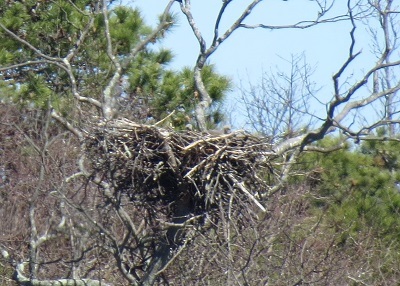
Photo reposted from 2017.
Park System Naturalists at the Manasquan Reservoir Environmental Center have been eagerly monitoring the site’s Bald Eagles’ nest for the first sign of hatching. It came early in the morning on March 15, when the female eagle was observed reaching down into the nest and delicately feeding her chick(s). This occurred right on schedule - approximately 40 days after the start of incubation on February 4.
At present, we do not know the number of eaglets since the newly hatched offspring are too small and weak to hold up their heads and be seen. We need to wait a few weeks for the chicks to grow before finding out.
Reminder: Nesting Bald Eagles are very sensitive to disturbance by humans. Approaching a nest by land or water could cause them to abandon their eggs or young. Do not approach the nest or enter any protected areas. The nest can be viewed safely from the trail adjacent to Georgia Tavern Road or from inside the
Manasquan Reservoir Environmental Center via a live television monitor. (posted 3/22/2022)
Madagascar Hissing Cockroach
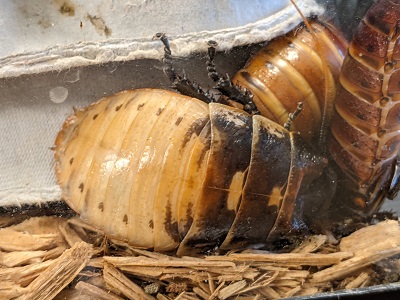
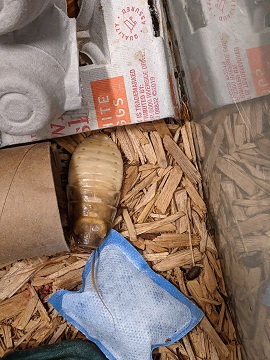
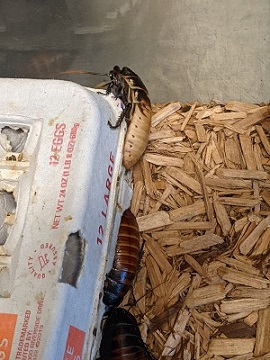
Native to Madagascar and known for their defensive hissing sound, the aptly named Madagascar Hissing Cockroach is one of the largest species of cockroaches (approximately 2-3" long) in the world when fully grown. The roaches shown above call the
Huber Woods Reptile House home. One is demonstrating a gradual metamorphosis process known as paurmetabola (Egg --> Nymph --> Adult). The ghostly looking roach is freshly molted!
Immature nymphs will molt six times in six months. After the final molt they are sexually mature adults and will not molt further. They are extremely vulnerable during their molting period as they are very soft and turn entirely pale white as shown above. In just a few hours, their exoskeleton begins to harden, and the cockroach slowly turns blackish/brown starting from the thorax to the abdomen. (posted 3/23/2022)
Blue-winged Teal
Photo by Al Rabbat Blue-winged teals are one of the tiny dabbling duck species that visit New Jersey every year. Some spend winters down in Central and South America but head back up to North America toward their breeding grounds in the spring.
They have a plain, buff colored body but stand out due to their blueish-gray head with a bold white crescent along its eye. But it’s when they open their wings and reveal their green colored secondary feathers and powdery-blue shoulder patch that they really stand out.
Al Rabbat took this photo of the bird’s wings flapping while we watched at close range from a blind during the March Birding Expedition when we visited South Cape May Meadows Preserve. (posted 3/18/2022)
American Bittern
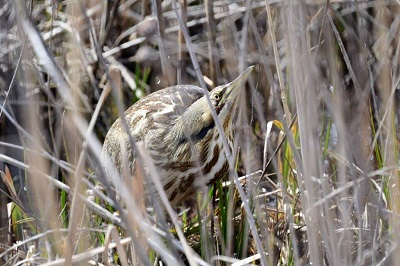
Photo by Eileen Gibney
American Bittern is a difficult species of bird to find. However, our Park System Naturalist’s keen eye picked up a perfectly camouflaged American Bittern hidden - and completely still - in a marsh during a recent Birding Expedition trip to Cape May Point State Park. A wading bird in the heron family, the American Bittern has streaky brown and buff colors with a thick and compact body. Eileen Gibney's photo demonstrates just how well this bird can disappear in the reeds. (posted 3/18/2022)
Beaver at Crosswicks Creek Park
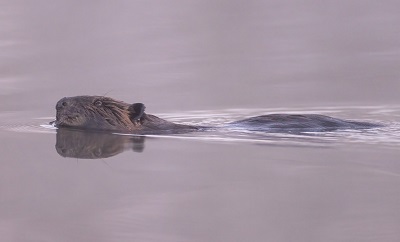
Photo by Mike Burke
Beavers may not be the first animal you think of when you think of Monmouth County, but they are found here! This beaver was photographed swimming in Crosswicks Creek Park by Mike Burke after he noticed the telltale signs of chew marks on trees and a lodge along the shore of a pond. Known for their large flat tail that they sometimes use to slap the water; beavers are the largest native rodent in North America and the second largest one in the world. (posted 3/18/2022)
Red-necked Grebe
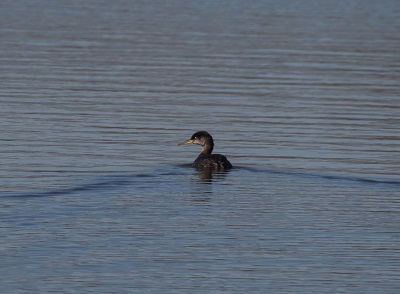
On a Park System Naturalist-led Birding Expedition in December, the bus traveled to the Assunpink Wildlife Management Area’s boat launch where participants were greeted by a Red-necked Grebe. Looking at the picture, the name may confuse you. Don’t let it. While the bird is named for the beautiful coloration of its breeding plumage, this one has its non-breeding plumage for winter migration.
Known to birders as having a bizarre behavior, Red-necked Grebes will ingest large quantities of its own feathers. It is thought to help in the bird’s digestion. An uncommon winter visitor in New Jersey, the Red-necked Grebe was a highlight of the trip. Other highlights include a Black-headed gull and Trumpeter Swans.
The Park System’s
Birding Expedition bus trips travel to local birding hot sports around the state to find as many bird species as possible. The goal of spotting interesting and rare visiting birds is usually the deciding factor on where to travel for the day. A schedule of upcoming trips is available on our
Programs & Registration page. Use for “Birding” in your search. (posted 2/23/2022)
Yellow-bellied Sapsucker
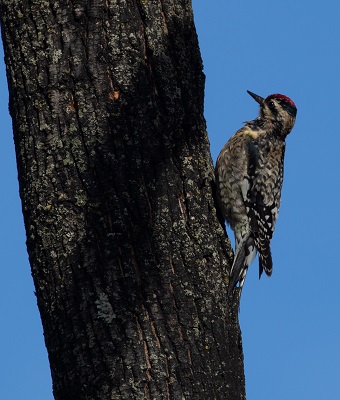
Have you ever seen a tree with rows of little holes that form straight horizontal lines? Then you have seen evidence of a Yellow-bellied Sapsucker, the only completely migratory woodpecker on the East Coast. These beautiful woodpeckers make small holes that cause the tree to release sap. Yellow-bellied Sapsuckers will periodically return to the tree to lap up the sticky sap and any insects trapped in it. An interesting fact about those sapsucker holes (sapwells) is that they also may attract hummingbirds looking for a sugary snack, especially during migration. (posted 2/23/2022)
Cuteness overload!
A PSA on how to help a seal hauled out on the beach.
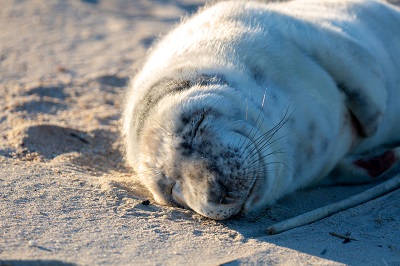
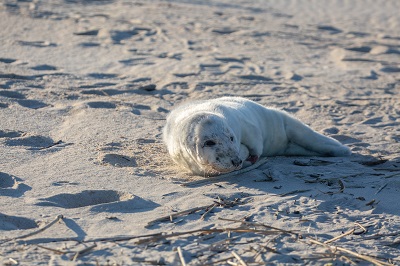
This seal was hauled out on a local beach. This can be very normal for seals. Please do not approach them as it’s best to give them wide berth and keep yourself, others and dogs far away. Seals have sharp teeth and claws and may defend themselves when provoked. The appropriate distance is far enough away that the seal looks small - roughly 150 feet.
If you get too close, you may spook them back into the water. Instead, call the Marine Mammal Stranding Center at 609-266-0538. The Center will send volunteers to sit on the beach and watch the seal, assess its health, and keep people and dogs away from the area.
The Center’s staff will make the decision to rescue the seal for rehab or wait for it to swim back into the ocean on its own. Often healthy seals will haul out on a beach or dock to rest, relax and digest. This helps them conserve precious energy. Other times, seals will haul out because they are sick or injured and need rehab to survive. (On a side note, if you see a seal eating sand, please let the rescuers know as it can be a sign that the animal needs help.)
This seal is a pup, estimated to be 4 to 8 weeks old, and was probably born in the waters of Maine or further north. Photos of it were obtained by trained volunteers and sent to the Marine Mammal Stranding Center. By the time Marine Mammal Stranding Center staff arrived, the pup had already returned to the water. (posted 2/14/2022)
Trumpeter Swan Pair
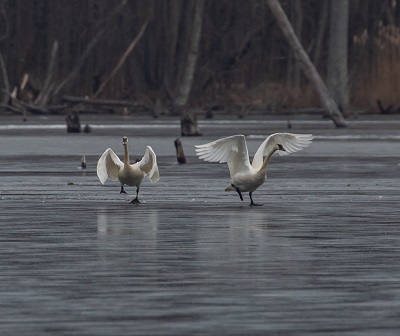
This Trumpeter Swan pair recently visited the Manasquan Reservoir to take refuge in the limited open water during the cold weeks of January. Trumpeter Swans are large swans that are similar in size to the more commonly seen Mute Swan. Trumpeter Swans are the largest native waterfowl of North America. Their size makes takeoff look quite lumbering, especially as they try to run down the lane of slippery ice. They are an infrequent winter visitor that attracted the attention of quite a few local birders. (posted 2/11/2022)
Back to Nature Now